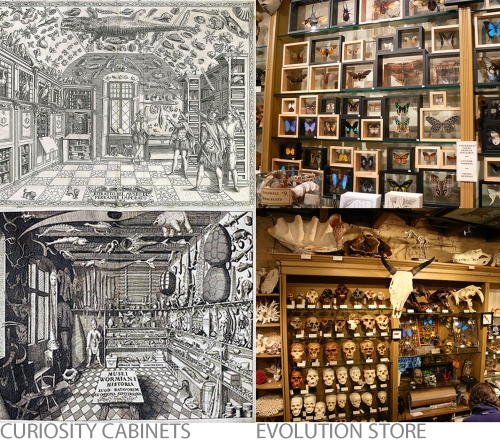 This store has been a landmark in Manhattan’s SoHo art district since 1993; it “sells unique natural history collectibles usually seen only in museums. These include butterflies and beetles, fossils, seashells, skulls and skeletons, medical models, and tribal art.” More here.
This store has been a landmark in Manhattan’s SoHo art district since 1993; it “sells unique natural history collectibles usually seen only in museums. These include butterflies and beetles, fossils, seashells, skulls and skeletons, medical models, and tribal art.” More here.
The second I walked into this store it immediately reminded me of the Cabinets of Curiosity; the way the objects are presented and the whole store is structured is similar to an early museum. For those of you who are not familiar with the Cabinet of Curiosities also known as Cabinets of Wonder, or Wonder-Rooms [Wunderkammern], these were encyclopedic collections of objects whose categorical boundaries were yet to be defined in Renaissance Europe . Modern terminology would categorize the objects included as belonging to natural history, geology, ethnography, archaeology, religious or historical relics, works of art and antiquities. It was regarded as a microcosm or ‘theater of the world’, and a ‘memory theater’.
Peter Thomas stated about Charles I of England’s collection that these were “a form of propaganda”, only for the aristocrats and only some could afford having them. Besides the most famous, best documented cabinets of rulers and aristocrats, members of the merchant class and early practitioners of science in europe formed collections that were in fact the precursors to public museums.
Clarisa Llaneza

Actually you can buy your own Cabinet of Curiosities at a number of locations. Maxilla & Mandible is on the Upper West Side a block or two from the American Museum of Natural History. There is also a very, very famous and exclusive taxidermy shop in Paris called Deyrolle. It burned last year and it was a real tragedy. I heard that a benefactor graciously stepped up with cash to rebuild it exactly as it was
I find in interesting that taxidermy and specimens, fossils, bones, botanical illustrations have seen a resurgence of interest in interior decorating. It is interesting that the power structure implied by the Cabinet has translated to the customer at the center of the commercial world. SOHO is a perfect place for this. You can buy all these wonderous and mysterious things and create your own visual catalog to represent the universe with you at the center. All you need is a credit card.
Though the power structure has changed somewhat, both are still consumers trying to “buy” prestige through consumption in commercial worlds–the purpose of collecting has remained unchanged. The original cabinet collector was buying and collecting rare objects (e.g things from far away lands that no one had ever seen before) as a means of showing off his/her wealth and educated taste. In the same mode, the modern-day collector–now not as class defined as before because anyone can be a collector of anything (salt and pepper shakers, U.S. state coins)–is still collecting objects to show off their knowledge of taste and to appear prestigious in appreciative eyes. The people, the goods and the classes may have changed, but the function of collecting has remained the same because collecting is necessarily consuming.
This store has to be one of the most interesting places in SOHO out of all the other stores. Entering this store on the weekends is the time when a diverse amount of people come and experience this store. its almost like this is the gift shop within the museum where everything has a price tag.
There is also something else that comes out of having this type of collecting available to a larger demographic. Interior design has been influenced both by the design of the space around particular objects, but also designers have created their own pieces with these objects.
http://crappytaxidermy.com/
you won’t regret it
It’s interesting how commerce can change your perception of an object. I had an experience earlier this week that reminded me of this. While visiting a gallery of rare (and extremely expensive) furnishings and decorative objects, the dealer commented that some pieces would be sold to museums, while others, the generally more costly objects, would most likely be bought by private collectors. What struck me was the effect of the context (or proposed contexts) on my perception of the object. In the dealer’s gallery objects could be handled, taken apart, used even (albeit gently). As soon as he mentioned that a piece was earmarked for a museum, I imagined it behind glass or cut off by a cord or platform. And my idea of its value increased. But it also reminded me of the physicality of objects in museums, and that most of these objects were at one time handled and used.